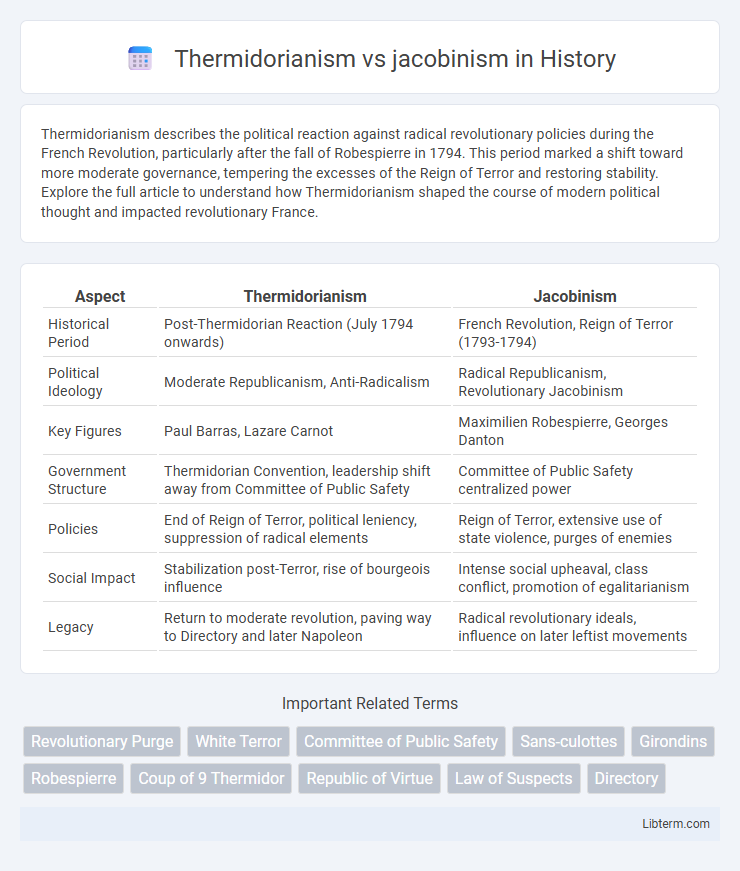Thermidorianism describes the political reaction against radical revolutionary policies during the French Revolution, particularly after the fall of Robespierre in 1794. This period marked a shift toward more moderate governance, tempering the excesses of the Reign of Terror and restoring stability. Explore the full article to understand how Thermidorianism shaped the course of modern political thought and impacted revolutionary France.
Table of Comparison
| Aspect | Thermidorianism | Jacobinism |
|---|---|---|
| Historical Period | Post-Thermidorian Reaction (July 1794 onwards) | French Revolution, Reign of Terror (1793-1794) |
| Political Ideology | Moderate Republicanism, Anti-Radicalism | Radical Republicanism, Revolutionary Jacobinism |
| Key Figures | Paul Barras, Lazare Carnot | Maximilien Robespierre, Georges Danton |
| Government Structure | Thermidorian Convention, leadership shift away from Committee of Public Safety | Committee of Public Safety centralized power |
| Policies | End of Reign of Terror, political leniency, suppression of radical elements | Reign of Terror, extensive use of state violence, purges of enemies |
| Social Impact | Stabilization post-Terror, rise of bourgeois influence | Intense social upheaval, class conflict, promotion of egalitarianism |
| Legacy | Return to moderate revolution, paving way to Directory and later Napoleon | Radical revolutionary ideals, influence on later leftist movements |
Introduction to Thermidorianism and Jacobinism
Thermidorianism emerged as a political reaction against the radical Jacobin regime during the French Revolution, advocating for moderation and the rollback of extreme revolutionary measures. Jacobinism embodied the revolutionary zeal of the Jacobin Club, promoting egalitarianism, centralization, and the Reign of Terror to enforce revolutionary ideals. These opposing philosophies defined the turbulent shift from revolutionary extremism to conservative stabilization in late 18th-century France.
Historical Context: French Revolution Background
Thermidorianism emerged after the fall of Robespierre in 1794, representing a reaction against the radical Jacobin policies during the Reign of Terror. Jacobinism, rooted in extreme revolutionary ideals, pushed for centralized power and widespread use of violence to achieve political and social reforms. The Thermidorian Reaction marked a shift toward moderation and a rejection of Jacobin extremism, reshaping the French Revolution's trajectory.
Core Ideologies: Comparing Thermidorian and Jacobin Beliefs
Thermidorianism emphasized a reaction against radical Jacobinism, advocating for a moderate republican government that prioritized stability, property rights, and a rollback of the Reign of Terror's extreme measures. Jacobinism was rooted in radical egalitarianism, centralized authority, and the use of state power to enforce revolutionary ideals such as wealth redistribution and secularism. The core ideological divide centered on methods of political control and social reform, with Thermidorians favoring pragmatic governance and Jacobins championing revolutionary zeal and purist republicanism.
Key Figures: Leaders of Thermidorianism and Jacobinism
Robespierre and Danton were the principal leaders of Jacobinism, advocating for radical revolutionary policies and centralized control during the French Revolution. Key figures of Thermidorianism included Paul Barras and Joseph Fouche, who orchestrated the fall of Robespierre and steered France towards a more moderate government. The contrasting leadership styles between the uncompromising Jacobins and the pragmatic Thermidorians significantly influenced the revolution's trajectory and the establishment of the Directory.
Rise and Fall: The Reign of the Jacobins
The rise of Jacobinism marked a radical phase during the French Revolution, characterized by centralized power under Robespierre and the Committee of Public Safety, enforcing the Reign of Terror to suppress counter-revolutionaries. Thermidorianism emerged as a reaction against this extreme Jacobin rule, culminating in the Thermidorian Reaction of July 1794 that ended Robespierre's dominance and the Terror. The fall of the Jacobins led to a more moderate phase, dismantling radical policies and setting the stage for the Directory government.
The Thermidorian Reaction: Turning Point of the Revolution
The Thermidorian Reaction marked a decisive turning point in the French Revolution by ending Jacobin dominance and initiating a more moderate phase. This shift dismantled the Reign of Terror, leading to the fall of Robespierre and the decline of radical Jacobin policies. Thermidorianism prioritized stability, curbed revolutionary extremism, and paved the way for the Directory government, contrasting sharply with the Jacobins' emphasis on revolutionary zeal and authoritarian control.
Political Structures: Governance Under Each Regime
Thermidorianism established a more moderate political structure with the Directory, emphasizing separation of powers and limiting radical influence compared to Jacobinism's centralized and authoritarian Committee of Public Safety. Jacobin governance enforced strict control through revolutionary tribunals and a centralized dictatorship under Robespierre, prioritizing ideological purity and mass mobilization. Thermidorianism reversed these trends, promoting political stability by decentralizing power and fostering a more conservative and bourgeois-dominated republic.
Social and Economic Policies: Contrasts and Impacts
Thermidorianism promoted a conservative social order with limited state intervention in the economy, favoring property rights and moderate taxation to stabilize post-Revolution France. In contrast, Jacobinism championed radical social equality through price controls, wealth redistribution, and state regulation of resources aimed at supporting the urban poor and wartime mobilization. These divergent policies led Thermidorianism to restore economic privileges for the bourgeoisie while Jacobinism's reforms temporarily addressed social inequities but resulted in economic disruption and political repression.
Legacy and Influence on French Politics
Thermidorianism marked a conservative reaction that curtailed radical Jacobin policies, favoring moderate republicanism and stabilizing French politics after the Reign of Terror. Jacobinism's legacy lies in its promotion of centralized authority, popular sovereignty, and social equality, which influenced future leftist movements and republican ideals in France. The enduring impact of Thermidorianism and Jacobinism shaped the balance between radical reform and political order in the trajectory of French revolutionary governance.
Conclusion: Lasting Effects of Thermidorianism vs Jacobinism
Thermidorianism marked a retreat from the radical policies of Jacobinism, leading to the stabilization of post-Revolutionary France and the eventual rise of the Napoleonic era. The Jacobin emphasis on centralized power and radical social reforms gave way to Thermidorian moderation, which promoted political pragmatism and curtailed the Reign of Terror. Long-term, Thermidorianism influenced the development of liberal constitutionalism, while Jacobinism left a legacy of revolutionary fervor and the importance of popular sovereignty in French political identity.
Thermidorianism Infographic

 libterm.com
libterm.com